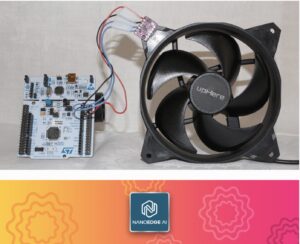To improve the accessibility of our content, please find the audio version of this blog post.
ST is releasing NanoEdgeTM AI Studio V3 today, an automated machine learning tool that features two additional machine learning algorithm families, simplified data logging, and a revamped user interface. The new software thus grows its reach by covering more use cases and becoming more straightforward to embedded developers. Our teams are also offering Edge AI Sprint Packages. The bundle helps teams bootstrap their projects thanks to training sessions and tech support, among other things. Therefore, today’s release is a testament to ST’s desire to make machine learning at the edge accessible to all.
What is NanoEdge AI Studio?
The Challenges Behind Creating Machine Learning Applications
In 2019, the ST Blog sat with the creators of NanoEdge AI to better understand its first machine learning application. Traditionally, large companies looking to benefit from machine learning must hire one or more data scientists to collect a massive amount of data for months, clean them, and create AI models. Embedded developers then port the implementation on microcontrollers or use tools like STM32Cube.AI to convert neural networks into optimized code for STM32 MCUs. When a company wrestles with tight budget constraints, hiring one or more data scientists may be out of the question. Additionally, it may not be possible to outsource the job. Some situations are sensitive, while others require someone to be constantly on staff.
Even with the right people and all the time in the world, obtaining quality data is still an issue. Despite all the advances in machine learning, getting reliable training samples can be a severe problem. For instance, if an application tries to detect abnormal behaviors, data may be unavailable. Indeed, while many datasets work for classification problems, such as anomaly detection, they’re useless when trying to detect new situations. It is also critical to obtain good quality data, which is far from obvious. When samples aren’t plagued by typos or missing information, recording clean sets and precisely labeling them can demand serious investments.
The Solution to Bringing Machine Learning Everywhere

NanoEdge AI Studio is a utility that speaks to embedded developers, even to those with no data science expertise. The magic lies in running the training phase that learns a complex nominal behavior and the inference on the same device. The entire process can thus run on the same STM32 microcontroller. Additionally, the end-user interaction can be simple, like pushing a button. As a result, engineers can customize their system to its local environment, making it more robust and easier to install.
NanoEdge AI Studio runs on Windows 10 or Ubuntu and is the best way to process data as well as find the most pertinent AI libraries. The application’s design focuses on embedded development and seamless integration in C applications. Put simply, NanoEdge AI Studio considers basic specifications like CPU, memory, sensors, and searches for the best NanoEdge AI library. It then outputs a library running on STM32 MCUs that developers can directly integrate into their embedded applications. And with today’s update, the utility offers more libraries as well as data logging capabilities.
What’s New in NanoEdge AI Studio?
Two New Families of Algorithms

Before today’s launch, NanoEdge AI Studio supported two major machine learning algorithms: anomaly detection and classification. With NanoEdge AI Studio V3, these two families now benefit from a more significant number of libraries. Moreover, we also optimized current algorithms to increase performance on existing use cases. Hence, embedded developers may experience better resource management or faster execution times when switching to the new software version.
The application also offers two new families of algorithms: extrapolation and outliers. The former helps anticipate behaviors in untested conditions. Also called regression, it maps the relation between multiple variables. For example, data sets could measure a fan’s behavior at 100ºC, 110ºC, and 150ºC. Now, thanks to a regression algorithm, the machine learning application can extrapolate the behavior at 160ºC. The extrapolation algorithm in NanoEdge AI Studio doesn’t only cover linear regressions. Indeed, it also offers more advanced analysis techniques to tackle complex situations. As a result, developers can now create new applications that monitor things that data scientists cannot test themselves.
The second algorithm is an outlier detection system that rests on a single class of values. Indeed, the system only learns normal behavior. Anything that deviates from it becomes an anomaly. Previously, when using the anomaly detection system, developers would record normal behavior, then simulate one or more problems. As mentioned, it was possible to learn all behaviors on the same microcontroller, thus vastly simplifying operations. However, in some cases, reproducing anomalies is simply impossible. Hence, outlier detection can use data from routine operations to infer an anomaly in such a situation.
New Effortless Data-Logging Features
Data scientists may run against the imperative to release the final product to market and may be stuck. Indeed, while there’s no better data than the one from real-world usage, it is not always available. Additionally, many are time-constrained. Hence, the new data-logging feature turns any STWIN SensorTile wireless industrial node into the most straightforward data collection tool. Users connect the board to their PC and use NanoEdge AI Studio to switch to data logging. Afterward, recording data becomes automatic. Engineers can fix the STWIN board to their equipment to monitor it. The sensors will record data that developers can then label and parse to create more accurate applications.
New Graphical User Interface
Another vital improvement in the new version of NanoEdge AI Studio is the user interface. With the arrival of new algorithms and data collection features, it was critical to improve the user experience. It was also crucial to optimize developers’ workflow. Indeed, NanoEdge AI Studio targets teams looking to bring machine learning to the edge. The libraries are tiny – as little as 1 KB – and highly optimized. It was thus necessary to also improve access to algorithms to ensure developers can easily select their project category and rapidly generate their libraries.
Experiencing NanoEdge AI Studio on Embedded Systems
Automating Machine Learning with NanoEdge AI Studio

Before the advent of NanoEdge AI Studio, engineers had to contact software vendors, go over their hardware configuration, and the behavior to monitor. Today, the tool enables developers to customize, generate, and validate their machine learning library. The utility first asks users to select their Cortex-M architecture and the sensor in the system. They then import a file with values describing the equipment’s typical behavior. It can be data from an accelerometer on a fan or the electrical information of industrial equipment. Afterward, NanoEdge AI Studio automatically tests, optimizes, and sorts the best algorithmic combination among hundreds of millions of possible combinations and produces a customized library that developers can validate using the embedded emulator.
NanoEdge AI Studio V3 now supports all ST development boards right from its user interface. The availability of optimized and free libraries thus means that running a proof-of-concept is straightforward. For instance, in the smart vibration sensor tutorial, users can grab the NUCLEO-L432KC to capture a fan’s normal behavior. They then feed the data to NanoEdge AI Studio and obtain a library that they can call in the main loop to run a minimum number of training cycles previously defined by benchmarks within the new software before engaging in inference. Hence, NanoEdge AI libraries can rapidly help create applications that use predictive maintenance, smart security operations, and more.
Bootstrapping Projects with Edge AI Sprint
Many customers fail to assess and demonstrate the benefits AI will bring to their application. Hence, to jumpstart applications on the right foot, Edge AI Sprint brings more than just a utility but a whole support system of experts that can guide developers through the minefields inherent to their application and use case. Edge AI Sprint is thus a bundle that includes training sessions, a NanoEdge AI Studio license, and technical support. Teams can select from various license duration, depending on their projects’ complexity, to ensure they can reach production. Meant to bootstrap a project’s first steps, Edge AI Sprint thus limits risks and investments while increasing the chances of success.
Next Steps
- Download NanoEdge AI Studio
- Contact your sales representative or authorized business partners to order a license for NanoEdge AI Studio and Edge AI Sprint
